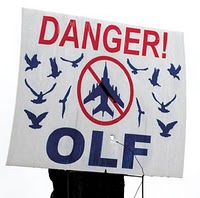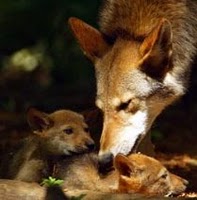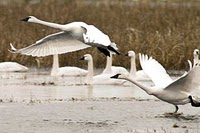 In a series of previous posts, I have discussed many different threats to the wild red wolf population in eastern North Carolina. About a year ago there was another topic that, had it not been abandoned, had the potential to threaten red wolves and several other wildlife species, as well.
In a series of previous posts, I have discussed many different threats to the wild red wolf population in eastern North Carolina. About a year ago there was another topic that, had it not been abandoned, had the potential to threaten red wolves and several other wildlife species, as well.
There was a proposal to place a naval outlying landing field (OLF) in the areas surrounding two of eastern North Carolina’s wildlife refuges. This Navy landing field would have been located within 3.5 miles of the Pocossin Lakes National Wildlife Refuge, where tens of thousands of migratory birds flock each year. The OLF would have also been stationed very close to the Alligator River National Wildlife Refuge, where the only wild red wolf population currently resides.
The Navy had been trying to establish the fighter-jet OLF in the area for almost five years. The plans suggested about 31,000 departures and landings a year, and many of them would occur at night. This constant onslaught of noise would be extremely stressful for many of the animal species living on the refuges, including red wolves. The noise would make it difficult for the red wolves to communicate with one another by their usual method of howling. The repeated low-level flight patterns of the jets would have also put migratory birds and pilots both at risk for deadly collisions. Fortunately, these concerns were addressed by conservation groups and local residents in several court cases against the Navy, and the plans were finally abandoned.
of the animal species living on the refuges, including red wolves. The noise would make it difficult for the red wolves to communicate with one another by their usual method of howling. The repeated low-level flight patterns of the jets would have also put migratory birds and pilots both at risk for deadly collisions. Fortunately, these concerns were addressed by conservation groups and local residents in several court cases against the Navy, and the plans were finally abandoned.
 of the animal species living on the refuges, including red wolves. The noise would make it difficult for the red wolves to communicate with one another by their usual method of howling. The repeated low-level flight patterns of the jets would have also put migratory birds and pilots both at risk for deadly collisions. Fortunately, these concerns were addressed by conservation groups and local residents in several court cases against the Navy, and the plans were finally abandoned.
of the animal species living on the refuges, including red wolves. The noise would make it difficult for the red wolves to communicate with one another by their usual method of howling. The repeated low-level flight patterns of the jets would have also put migratory birds and pilots both at risk for deadly collisions. Fortunately, these concerns were addressed by conservation groups and local residents in several court cases against the Navy, and the plans were finally abandoned. At least for now, these beautiful sanctuaries for our wildlife are not under any threat of an OLF. But this sort of p roposal brings up an important question for the U.S. Fish and Wildlife Service (USFWS): Are there any alternate wild population locations for red wolves in the future? Stay tuned for my next post where I will talk about how the USFWS is addressing this question in regards to the current location at Alligator River National Wildlife Refuge (ARNWR) and whether it could soon reach its carrying capacity for red wolves.
roposal brings up an important question for the U.S. Fish and Wildlife Service (USFWS): Are there any alternate wild population locations for red wolves in the future? Stay tuned for my next post where I will talk about how the USFWS is addressing this question in regards to the current location at Alligator River National Wildlife Refuge (ARNWR) and whether it could soon reach its carrying capacity for red wolves.
 roposal brings up an important question for the U.S. Fish and Wildlife Service (USFWS): Are there any alternate wild population locations for red wolves in the future? Stay tuned for my next post where I will talk about how the USFWS is addressing this question in regards to the current location at Alligator River National Wildlife Refuge (ARNWR) and whether it could soon reach its carrying capacity for red wolves.
roposal brings up an important question for the U.S. Fish and Wildlife Service (USFWS): Are there any alternate wild population locations for red wolves in the future? Stay tuned for my next post where I will talk about how the USFWS is addressing this question in regards to the current location at Alligator River National Wildlife Refuge (ARNWR) and whether it could soon reach its carrying capacity for red wolves.The information in this post can be found here.
